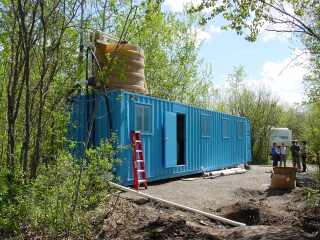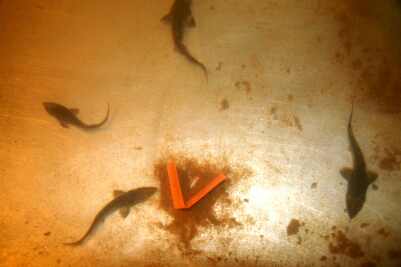These are pictures taken of the Pilot Conservation Hatchery that was installed in May 2006 in Vanderhoof.

May 25, 2006: Freshwater Fisheries Society staff got the pilot conservation hatchery up and running in only 48 hours! The fertilized eggs were transported from Prince George to Vanderhoof and placed in the hatchery to be monitored and cared for.

May 25, 2006: In order to maximize genetic diversity, the TWG created 4 half sibling families from the 2 females and 4 males captured for the project. Female A's eggs were fertilized by males 1 and 2, and female B's eggs were fertilized by males 3 and 4. The fertilized eggs were placed in 4 separate water columns to keep each of the half sibling families separate during egg growth and hatching. Water is circulated through the column to keep the eggs oxygenated and moving gently. This mimics the natural conditions in the Nechako river.

May 25, 2006: A closer look at the fertilized eggs. They are brown in colour and quite sticky. They are 4 days old, and will hatch in approximately 7-10 days.

June 9, 2006: Success! Approximately 8000 larvae from female A and 3000 from female B have hatched. They are actively feeding. Although they look somewhat like tadpoles, you can see barbel and fin development beginning.

July 31, 2006: These are some of the wild-spawn sturgeon swiming in their rearing tank.

July 31, 2006: A close up of the wild-spawn juveniles.

August 8, 2006: Measuring the juveniles gives a great opportunity for a close up!

August 8, 2006: And one more!

Late August 2006: Hatchery working at full steam! You can see the 4 rearing containers, each one holding one of the half families of juvenile sturgeon.

Late August 2006: An aerial view of one of the rearing containers. There are approximately 1500 fish in this tank.

Late August 2006: Wow - they look just like miniature adults! Thanks to Kevin Wallace from Wallace's Custom Studio in Vanderhoof for this great shot.